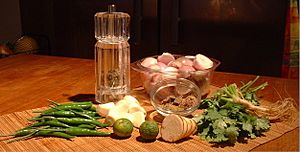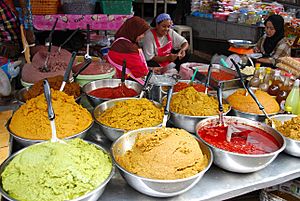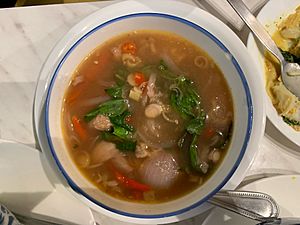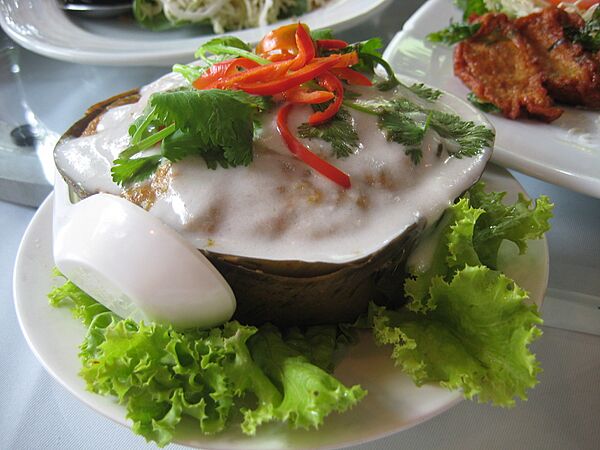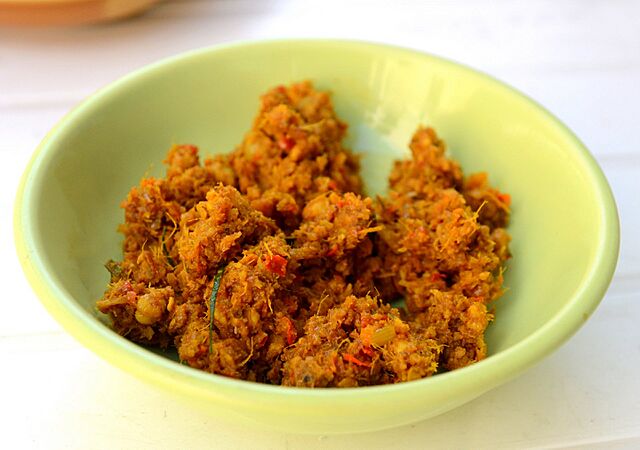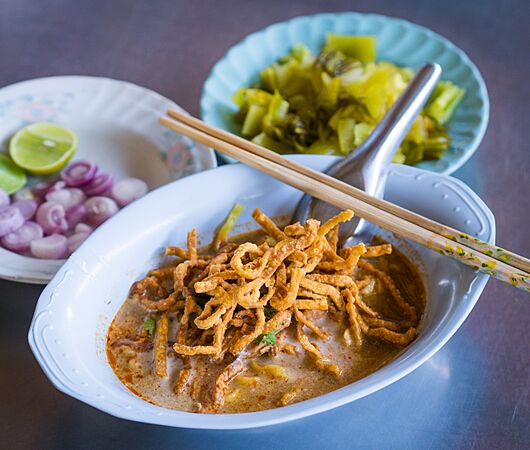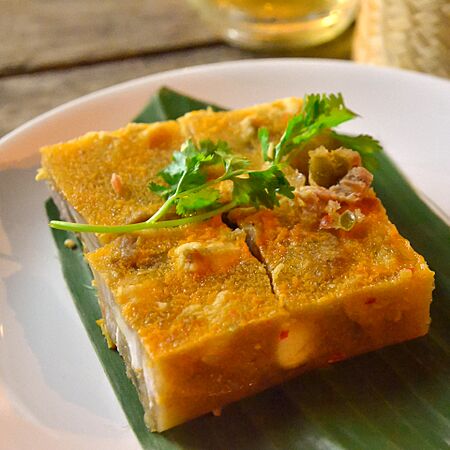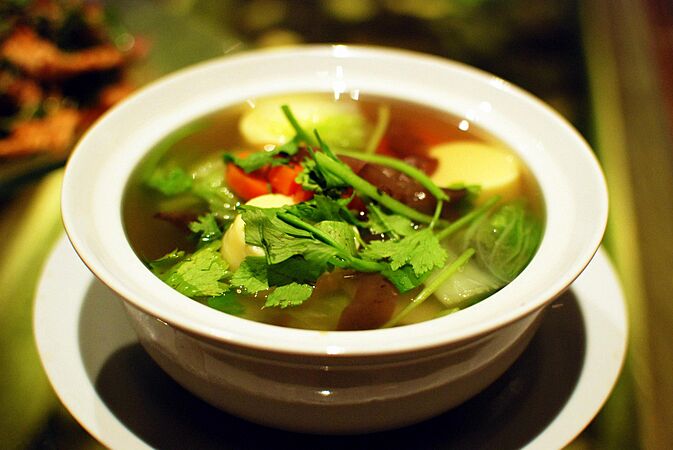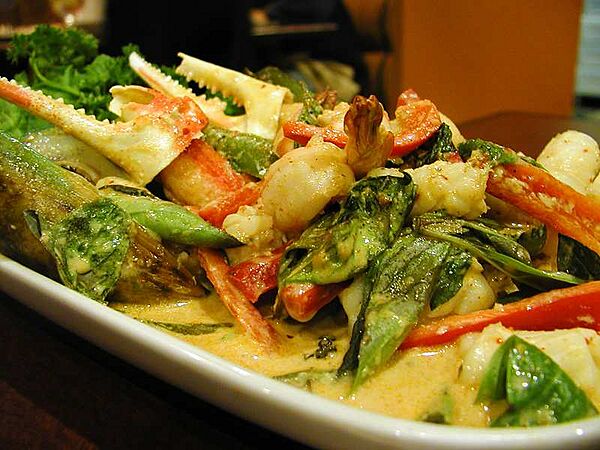Thai curry facts for kids
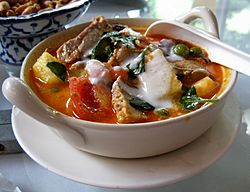
A bowl of kaeng phet pet yang, roast duck in red curry
|
|
| Type | Curry |
|---|---|
| Place of origin | Thailand |
| Main ingredients |
|
Thai curry (Thai: แกง, romanized: kaeng) is a popular dish from Thailand. It's made with a special curry paste, coconut milk (or water), and ingredients like meat, seafood, vegetables, or fruit, along with fresh herbs. Thai curries are different from Indian curries because they often use more fresh herbs and leaves instead of just a mix of dried spices.
Contents
What is Thai Curry?
The first Thai dictionary from 1873 explained kaeng as a watery dish eaten with rice. It said the main ingredients were shrimp paste, onions or shallots, chillies, and garlic. Interestingly, coconut milk was not part of this early definition.
Many Thai curries, like kaeng som and kaeng pa, still don't use coconut milk today. For example, in Lanna (northern Thailand), coconut palms don't grow well. Because of this, most northern Thai curries don't use coconut milk.
The spiciness of a Thai curry depends on how many and what kind of chillies are used in the paste. Even the same type of curry can be very spicy or quite mild!
The word "curry" in Thai is "kari" (Thai: กะหรี่). This word usually means dishes that use an Indian-style curry powder. An example is Kung phat phong kari, which is prawns fried with egg and curry powder.
Even though kaeng is often called "watery," the sauce can be thin like a broth or thick like a stew. Some Thai curries are even dry dishes, like phat phrik khing and khua kling.
Other dishes like Ho mok pla (a steamed fish curry) and kaeng kradang (a curry jelly from northern Thailand) are also considered Thai curries. This is because they all use a special curry paste when they are made.
One exception is kaeng chuet. This dish is a clear Chinese-style broth with vegetables and sometimes minced pork or tofu. Its name means "bland curry," but it's actually a type of soup, often called tom chuet.
Thai curries are usually eaten with rice. In central and southern Thailand, people eat them with long-grained jasmine rice. In northern and northeastern Thailand, they prefer sticky rice. Curries can also be served with noodles like khanom chin (fermented rice noodles) or with roti, which is a Thai version of an Indian-style fried flatbread.
Khao kaeng or khao rat kaeng means "curry-on-rice." These are traditional fast food restaurants in Thailand that specialize in ready-made curries served with rice.
Common Ingredients in Thai Curry
Curry Paste
All Thai curries start with a special curry paste. Here are some common ingredients found in many Thai curry pastes:
- Shrimp paste
- Chillies: These can be dried or fresh, red or green, depending on the curry.
- Onions or shallots
- Garlic
- Lemongrass
- Galangal
- Coriander (cilantro) root
Some curry pastes might also include spices like turmeric, pepper, coriander seeds, cardamom pods, and cumin. Other ingredients can be boiled fermented fish or fingerroot.
Traditionally, these ingredients are ground together using a mortar and pestle. However, many people now use an electric food processor. For many curries, the paste is first stir-fried in cooking oil. This helps the flavors in the spices and other ingredients really come out.
In Thailand, "curry paste" is called khrueang kaeng (meaning "kaeng ingredients") or nam phrik kaeng (meaning "kaeng chilli paste"). You can make Thai curry pastes at home, buy them fresh at markets in Thailand, or find them packaged in stores.
Main Ingredients
Most Thai curries use meat, fish, or shellfish as their main ingredient. But you can also add vegetables and fruit. Some unique additions include leaves from certain trees, like cha-om or phak lueat, and flowers like those from the Sesbania grandiflora or banana flowers (hua pli).
Curries that mainly contain vegetables include kaeng liang (mixed vegetables) and kaeng nomai (bamboo shoots). The ingredients used often depend on what's available in the area and what's in season. For example, pork and chicken are easy to find. So are many types of fish and shellfish from rivers, lakes, and the sea.
In the past, traditional Thai curries also used ingredients like frogs, snakes, snails, wild birds, and game animals like Sambar deer and wild boar. Common vegetables in curries today include Thai eggplant (makhuea pro), yardlong beans (thua fak yao), and different kinds of squash and pumpkins (fak).
Extra Flavorings
Fresh kaffir lime leaves (bai makrut), fingerroot (krachai), or fresh herbs like Thai basil (horapa) are often added to Thai curries. Kaffir lime leaves and krachai are usually cooked with the other ingredients. However, fresh herbs like Thai basil are almost always added at the very end. This keeps their full flavor and adds a fresh taste to the curry.
Fish sauce is used to give the curry flavor and a salty taste while cooking. It's also often placed on the table as a condiment. People can mix it with sliced green bird's-eye chillies if they want their curry saltier and spicier. Sugar (traditionally palm sugar) is used to sweeten curries. For sour curries like kaeng som, tamarind juice can be used instead of lime juice.
To get the best smell and taste from the ingredients in a curry paste, the paste is often fried first with vegetable oil or with coconut oil that has separated from the coconut cream. Then, the other ingredients are added.
Popular Thai Curries
- Kaeng kari (known as "yellow curry" in Western countries)
- Kaeng khae, a curry from northern Thai cuisine.
- Kaeng khiao wan (meaning "green sweet curry," known as "green curry" in Western countries)
- Kaeng pa (meaning "jungle curry," it uses whatever is found in nature)
- Kaeng phet (meaning "spicy curry," known as "red curry" in Western countries)
- Kaeng som (meaning "orange curry," each region has its own version)
- Kaeng matsaman (meaning "Muslim curry"; the name might come from "mosalman," an old word for "Muslim")
- Kaeng Ranjuan (a spicy, sour, sweet, and salty beef curry, often made from leftover food)
- Khao soi (a Burmese-influenced curry noodle soup from northern Thailand)
- Phanaeng (this is a creamy and usually mild curry; its name might come from the Malaysian island of Penang)
- Phat phrik khing (meaning "stir-fried chilli ginger," but this Thai curry actually does not contain ginger)
Gallery
-
Phanaeng paste is fried together with coconut cream
-
Khao soi, a curry noodle soup from northern Thailand
-
Kaeng kradang, a pork curry aspic
-
Kaeng tai pla, made from fermented fish entrails
-
Kaeng hang le, a northern Thai curry with Burmese influences



